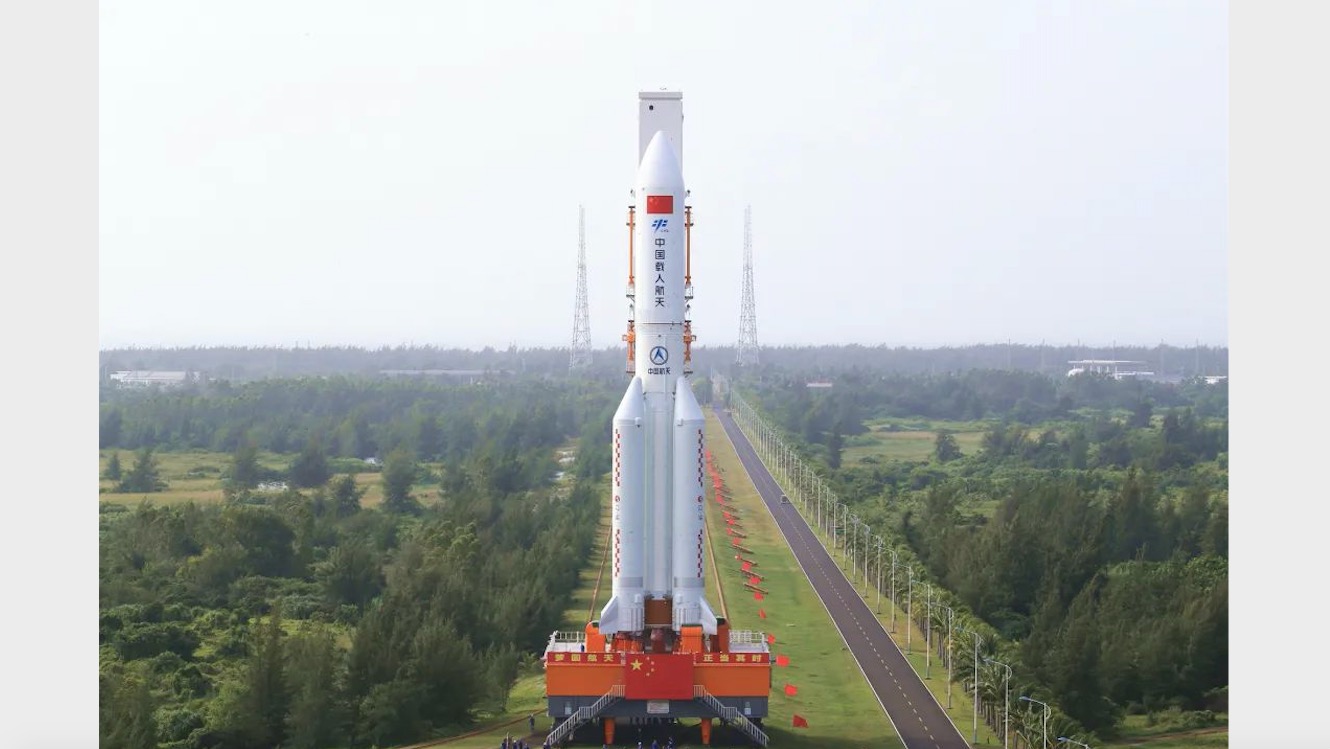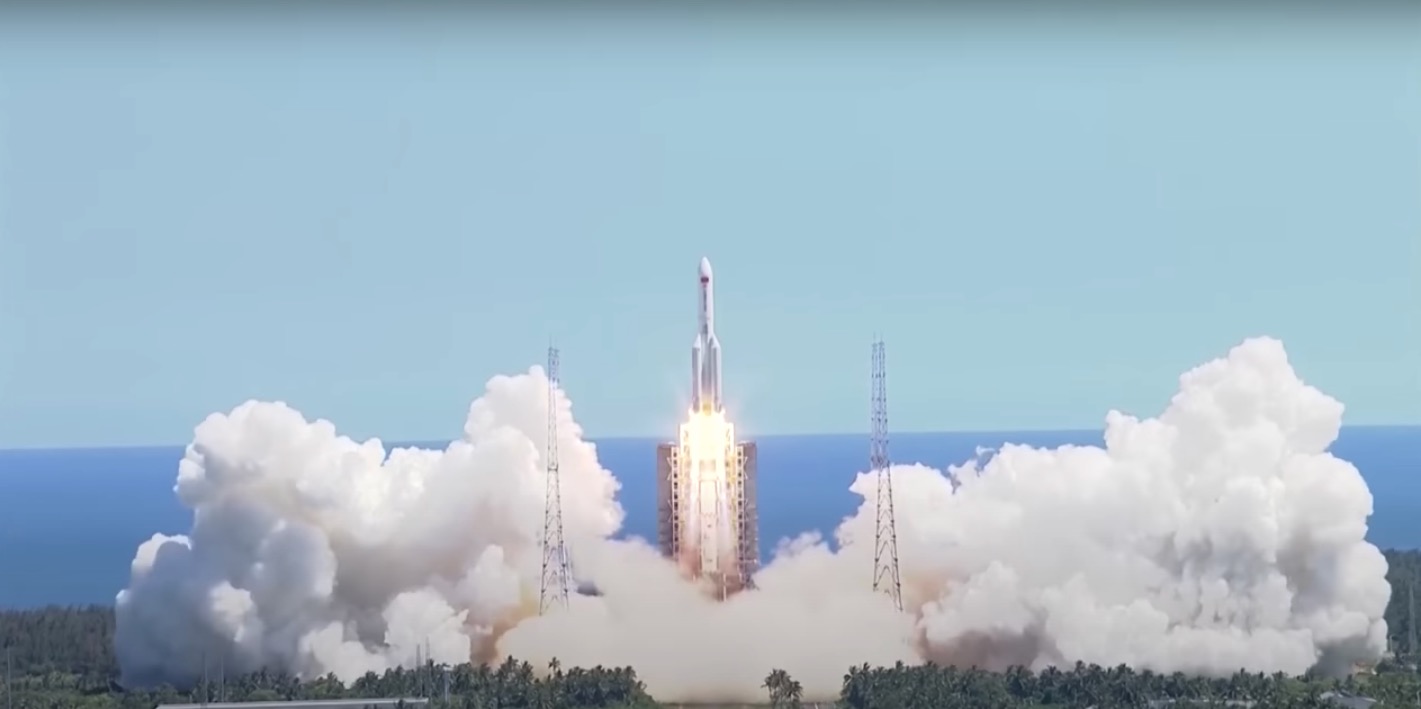
Chinese launch next week will set stage for another big space-junk crash
Get ready for another uncontrolled rocket fall.

China's Mengtian space station module is on the launch pad, being readied for a reported liftoff on Oct. 31 atop a powerful Long March 5B rocket from the Wenchang Spacecraft Launch Site on the island of Hainan.
The liftoff will be a big one for China; Mengtian is the third and final module for the nation's Tiangong space station.
Many eyes will therefore be on the launch — and also on its aftermath. When their missions are over, Long March 5B core stages fall back to Earth uncontrolled, so where they land becomes a spin of the roulette wheel.
Related: The biggest spacecraft to fall uncontrolled from space
Guessing game
Once again, the guessing game of just where on the planet the core stage's fiery reentry will occur is sure to absorb extensive time of space junk trackers — and for good reason.
The Long March 5B core stage is estimated to weigh around 23 tons (21 metric tons). That's about twice the mass of an average school bus, or the empty mass of a Boeing 737. Experts predict that 20% to 40% of the core stage will survive reentry and hit the surface. But which surface? Ocean or land?
By design, the core stage of the Long March 5B reaches orbit rather than coming back down shortly after liftoff. Consequently, previous launches of the hefty rocket have resulted in uncontrolled reentries as the core stage naturally falls out of orbit a week or so later, risking serious damage on the ground.
Get the Space.com Newsletter
Breaking space news, the latest updates on rocket launches, skywatching events and more!

International law
In 2020, debris from a Long March 5B landed in Cote d'Ivoire, damaging several buildings. And this year, some pieces hit land in Indonesia and Malaysia, noted Harry Boneham, an aerospace analyst at the London-headquartered analytics company GlobalData.
"Under international law, specifically the Convention on International Liability for Damage Caused by Space Objects, which elaborates on Article VII of the Outer Space Treaty, China would be liable to pay compensation for damage caused by its space objects on the surface of the Earth," Boneham told Inside Outer Space. "However, enforcement would be a difficult process."
Looking forward, it is unlikely that China will move away from using the Long March 5B.
It is China's most powerful rocket and currently its sole option for heavy-lift launches. There are only two more launches of the Long March 5B officially planned, including the Mengtian mission. China is also planning on launching a space telescope, called Xuntian, in 2023 using the big booster.
But, given China's ambition to establish a leading presence in space, further Long March 5B launches would not be a surprise, Boneham said.
"China is developing the super-heavy lift Long March 9, but first flight is not expected until the end of the decade, and low Earth orbit launches would be inefficient except for extremely heavy payloads. Additionally, China is beginning to develop reusable rocket boosters, which would clearly remove the issue of uncontrolled booster reentry," Boneham said.
"However, development is at an early stage and only appears to be focused on the smaller Long March 2, probably for crew and cargo transfer," he added. "For the foreseeable future, for carrying heavy payloads to low Earth orbit this decade, the Long March 5B is China's main option."
Related: China's Long March rocket family: History and photos
Share details
Given China's continued use of the Long March 5B variant, Boneham said that there are actions that could be taken to limit the risk to life and property from reentering debris.
"For instance, during the last reentry of a Long March 5B booster in July 2022, it was reported that Chinese authorities did not share details regarding specific trajectory information with the wider global community, which would have allowed a degree of forewarning in areas at risk from debris," Boneham said. "Refusing to share this information does not ameliorate the reputation of the People's Republic of China when it comes to conduct in space."
Updates
In the meantime, Liu Bing, deputy director designer of the Long March 5B, recently told China Central Television that "an elaborative evaluation" was carried out after rocket specialists "planned its orbit to enable a successful entry."
It remains unclear what proactive steps, if any, China has taken to assure that core stage leftovers come back to Earth in a safe fashion.
One group that's planning to monitor the upcoming Long March 5B launch and any possible uncontrolled reentry that may result is The Aerospace Corporation.
As with previous uncontrolled reentries, the California-based nonprofit corporation will be posting updates on its Center for Orbital and Reentry Debris Studies website, as well as through social media channels.
Leonard David is author of the book "Moon Rush: The New Space Race," published by National Geographic in May 2019. A longtime writer for Space.com, David has been reporting on the space industry for more than five decades. Follow us on Twitter @Spacedotcom or on Facebook.
Join our Space Forums to keep talking space on the latest missions, night sky and more! And if you have a news tip, correction or comment, let us know at: community@space.com.

Leonard David is an award-winning space journalist who has been reporting on space activities for more than 50 years. Currently writing as Space.com's Space Insider Columnist among his other projects, Leonard has authored numerous books on space exploration, Mars missions and more, with his latest being "Moon Rush: The New Space Race" published in 2019 by National Geographic. He also wrote "Mars: Our Future on the Red Planet" released in 2016 by National Geographic. Leonard has served as a correspondent for SpaceNews, Scientific American and Aerospace America for the AIAA. He has received many awards, including the first Ordway Award for Sustained Excellence in Spaceflight History in 2015 at the AAS Wernher von Braun Memorial Symposium. You can find out Leonard's latest project at his website and on Twitter.








